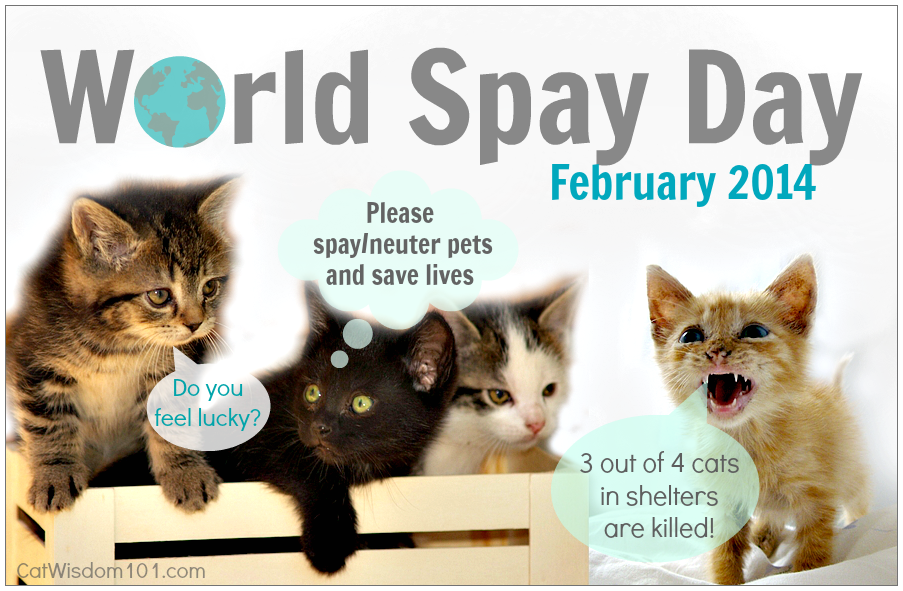
World Spay Day
In honor of World Spay Day we’re re-posting a guest post on a timely topic by Veterinarian and CWA Cat Writers’ Association president Lorie Huston.
Our readers are savvy about the need to spay/neuter but I’d like to share a surprising stat. Did you know it costs U.S.taxpayers 2 Billion Dollars annually to round up, house, kill and dispose of homeless (and usually unspayed/neutered) animals in shelters
Why Should You Spay or Neuter Your Cat
by Lorie Huston DVM
Springtime is fast approaching and with it comes kitten season, that time of year when communities are overrun with litters of homeless kittens. The luckiest of these kittens find their way to shelters and rescues that ultimately will find homes for them. Unfortunately, not all of these kittens will be so lucky.
Reducing the number of homeless cats and kittens is one reason to spay or neuter your pet cat. And it’s a good one. Simply put, it’s what responsible cat owners do. However, reducing the feline overpopulation problem is not the only benefit to spaying or neutering your cat.
There are numerous health and behavioral benefits to spay/neuter.
- Female cats that are spayed, especially those that are spayed at an early age before their first heat cycle, have a significantly lower risk of mammary cancer than those cats that are not spayed. This is an important health benefit but it’s not the only one.
- When a female cat is spayed, her ovaries are both removed. Usually the uterus is also removed. This prevents your female from coming into heat. If you’ve ever lived with a cat that is heat, you already know it’s not a pleasant experience. Female cats vocalize, usually loudly and persistently, when they are in heat.
- Their behavior becomes erratic, often alternating between friendliness and irritability. Keeping your cat inside and away from any intact males (even those that are related to her) is essential when your cat is in heat. Otherwise, you’ll likely find your cat has gotten pregnant. For many cat owners, living through one heat cycle with their cat is enough to tip the scales in favor of spaying.
- Pyometra is a severe uterine infection that can prove to be life-threatening for unspayed cats. Cats develop this infection because of the changing hormone levels associated with coming in and out of heat. Spaying prevents this infection from occurring, another significant health benefit.
- A behavioral issue often found in unaltered cats is spraying. Both male and female cats can spray though it is more common in male cats. Cats spray to mark their territory and tell other cats to stay away. It is a form of inappropriate urination. By definition, spraying involves urinating on a vertical surface like a wall. However, some cats will also urinate on horizontal surfaces to mark territory. Although spaying or neutering will not stop this spraying behavior in all cats, the majority of altered cats do not spray.
- Neutered male cats tend to be less aggressive toward other cats and are likely to fight less than those that are not neutered. In addition, neutered male cats are more likely to be content to stay in your home or at least not wander as far from home in search of a female cat in heat if you do allow them outdoors.
Cats can reach sexual maturity by 6 months of age. Ideally, they should be spayed or neutered prior to this age. Kittens are routinely spayed and neutered as early as 6-8 weeks old, particularly in shelter and rescue situations. Early age spay/neuter allows kittens to be altered before leaving the shelter/rescue environment. However, if your cat is over 6 months of age, it’s not too late to spay or neuter. Cats of any age can be altered as long as they are healthy enough to undergo anesthesia.
Author bio:Lorie Huston is a veterinarian with over 20 years of experience working with dogs and cats. She currently practices in a busy urban setting. She is also a talented author, writer, blogger, and a Certified Veterinary Journalist (CVJ). You can find more about Huston at her pet health blog Pet Health Care Gazette. Her book Labrador Retrievers: How to Be Your Dog’s Best Friend is available on Amazon.





23 Comments
Oui Oui
The mom’s first cat, Leia, was pregnant when the mom took her in off the streets and she went into heat while her kittens were still nursing. The vet didn’t want to spay her until they had been weaned. It was such an awful experience, the mom always made sure her cats were spayed early, never wanting to repeat that again.
meowmeowmans
Thank you for sharing such important information! We’re late getting here, but we will share this on Twitter right now.
Tamago
Surprisingly some people don’t think spay/neuter is that important.
Great post to spread the word and raise awareness!
Skeeter and Izzy
It is the RIGHT thing to do,it is the SIMPLE thing to do and it is part of an EASY solution to homeless animals and overpopulation.
JUST DO IT PEOPLE!!!!!!!!!!!!!!!!!!!!!!!!
We preach this message almost daily in our community along with the heartbreaking realities of shelters and feral living. I think that we sugar coat the realities in so many ways. I cannot believe the people that look at me aghast when I relay the cold hard facts to them but many of them are spurred to some kind of action by the realizations. We CAN FIX THIS PROBLEM!!!!!
Luvs Skeeter and Izzy and the Feral Gang + Twig and Peanut = 9 cats all spayed and neutered and proud of it !!!! >^..^<
Layla Morgan Wilde
YES, no more excuses, just do it. We are preaching to the choir here so it’s up to us who know better to keep spreading the message.
Angel AbbyGrace
We sure wish so many more would spay/neuter so there would be less problems with over population.
Brian Frum
This important message cannot be repeated enough!!!
Marg
Great post. My favorite subject. Wish we could get more cats and dogs spayed. It sure would cut down on homeless animals. Just need to somehow educate the public. Take care.
Famous SpokesGoat Pricilla
All of the Farm cats are fixed. Heaven knows we do not need another Sherpa running around. ::Shiver::
Crepes
three out of four?? What a terrible statistic!! Ugh. Sharing, for sure. – Crepes.
Layla Morgan Wilde
It’s actually a bit higher but I wanted to show four cats.
Nerissa's Life
Such INCREDIBLY IMPORTANT information. I’m sharin’ your post to help spread the word.
Purrs,
Nissy
Coccolino
What a good article. That statistic of 3 out of 4 shelter cats being killed makes me so sad, it’s just not fair. World Spay Day is so important.
da tabbies o trout towne
grate post doodz….it bearz ree pete inn…again N again N again til peepulz FINAL LEE get de message….
easy rider
I hope my neighbor will read this post. He can learn a lot I think. And if he would make the right decision, it would be easier for his cat and for him. Many thanks for your post!
Sammy
We shared on Facebook – with Sam’s moon trip I’d forgotten about this most important day…….!!
Hugs, Pam
Sometimes, Cats Herd You
Great list. Some people need to be reminded of the benefits, as if doing their part to help stop overpopulation isn’t enough.
Kathryn
Such excellent info. Long ago, in Chicago, the shelter said NOT to spay when we picked up our cat. I can’t remember what their reason was, but this was 1972. We tried to obey, but Emma’s constant vocalizing was just too much. My parents always spayed our cats and it makes sense for all the reasons you give. Emma lived to be 20.
Layla Morgan Wilde
In those days they felt a cat needed to be older to be spayed but we’ve thankfully come a long way since.
d'Artagnan Rumblepurr
An excellent article!
Sparkle
Ugh! I can’t believe I forgot World Spay Day is today! I am going to mark it on my calendar for future reference.
Pawesome Cats
Great article! The more we share this message the more we can help to reduce overpopulation and numbers in shelters.
Layla Morgan Wilde
The more info the better. We shared your post on Facebook.